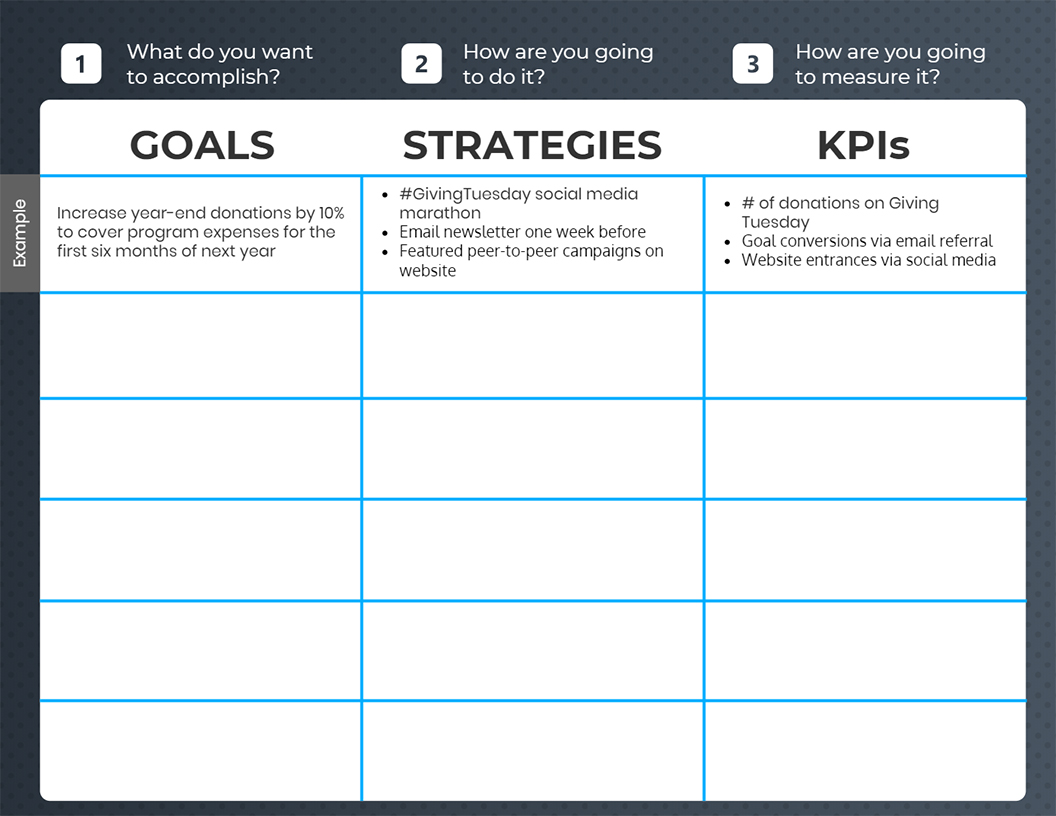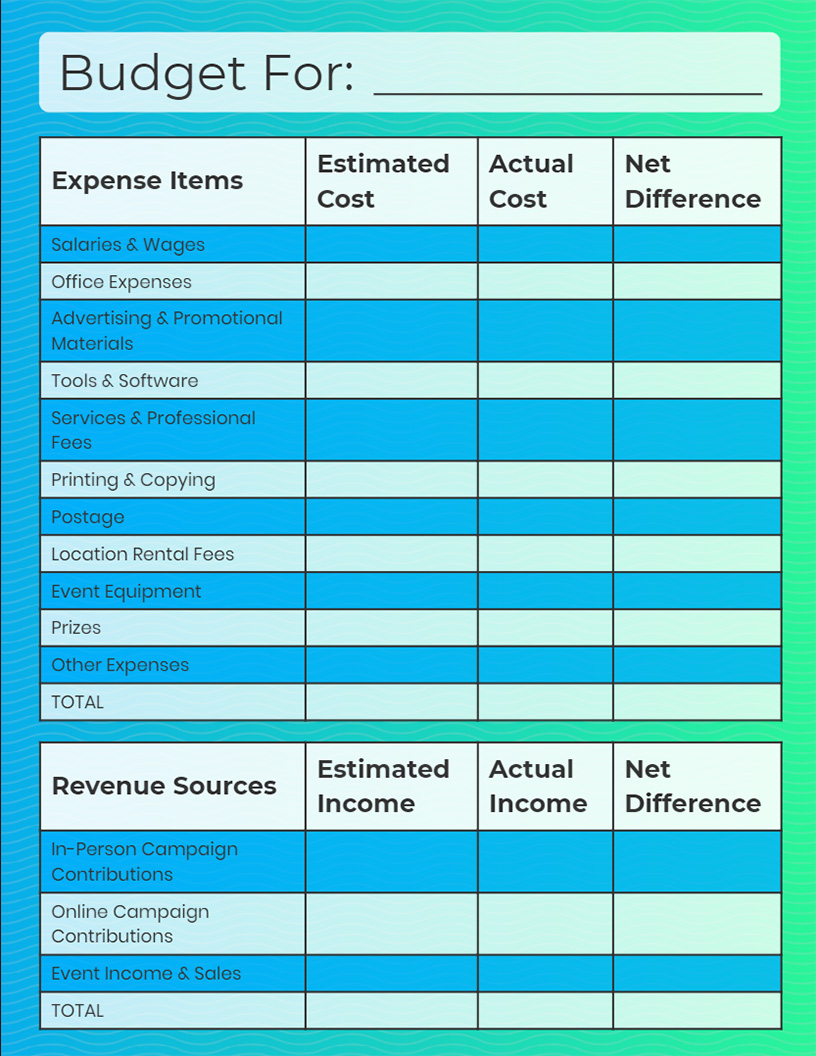3 Super Handy Worksheets For Year-End Giving
You know the old saying: “When the leaves turn brown, some serious fundraising’s about to go down.” OK, so maybe I just made that up; but that doesn’t make it any less true. The average nonprofit can expect to receive about half — or even more — of its fundraising revenue in the fourth quarter. And if you haven’t thought about your year-end giving plan before the pumpkin spice lattes hit the shelves, you might not be making the most out of this critical time of year for nonprofits.
At Click & Pledge, we definitely notice the giving spirit come out at this time of year. And while it might seem more appealing to wear a parka in a steambath than to create a year-end giving plan, it doesn’t have to be so stressful. In fact, we put together this guide (and a few simple worksheets) to help you knock out the basic components in just a couple of hours.
So, ditch the parka for a chair and a nice pumpkin spice latte, and let’s dive in.
1. Outline Your Objectives
A plan is only as good as its goals. That means you should look to accomplish something feasible, concrete, and measurable with your year-end giving plan. Start by considering these questions:
- How much fundraising revenue did you earn during last year’s campaign?
- What could be done differently to make this year’s campaign better?
- How much do you expect your budget to grow this year?
- What, if any, holes do you foresee with your programming budget that need to be addressed?
- Why is it important that we address these budgetary concerns with our year-end fundraising?
For something more concrete, try filling out this sentence:
“For this year-end giving plan, our organization’s priority is to insert specific result to insert specific organizational need(s) to address.”
There’s another important aspect here: timing. How long do you plan to run your year-end giving campaign? On one hand, your end-date should almost unanimously be at least January 1. That’s because every year, the most donations happen in the last week of December. You can even extend the deadline for those patrons participating in corporate matching gifts programs that usually implement a grace period.
Whether you choose to kick off your campaign with a Halloween Haunt, or a Giving Tuesday marathon, or a donation drive starting December 1 — it totally depends on your organization’s preparedness and donor base. Go back to your data from last year’s campaign to see when it was launched, and whether donations played a significant impact during a specific time frame.
2. Tell The Story
Most donors are driven by an organization’s mission, not necessarily the numbers. It’s a lot easier for people to digest your mission with your organization’s story, rather than plain statistics.
Stories create social bonding experiences, which cause your brain to release oxytocin, a chemical partly responsible for creating lasting memories and strong emotions. Even the most beautiful annual report infographic doesn’t compare if it’s flooded with statistics.
What are some of the stories that have popped up out of your organization over the last year? What’s the real-life, human story behind your fundraising goal? Instead of talking about X number of people you’ve served or plan to serve, focus on one person’s story.
There are endless ways to tell that story. Maybe it’s a mini-documentary, or a blog post, or a podcast, or a photo collage. It’s up to you to decide what’s both powerful and feasible for your organization. However you do it, there will be multiple ways to let donors know about that story. Which brings us to…
3. Define Your Communications Channels
So now that you have an idea of what you want to do, you’re going to need to find out how you’re going to accomplish it. At this point, it’s a good idea to look at how patrons interact with your organization. Who are they? What are their goals for your organization? What interests them the most? If you’ve never developed a donor persona before, it’s time to make like a high school biology student and dissect.
A good place to start is with traditional demographics like age, gender, and income; but don’t stop there. Get to the nitty-gritty, and you can even be a little imaginative. Is your typical donor a tennis enthusiast who checks her email between sets? Perhaps they’re really into drone-racing and watch how-to instructional videos. Whatever their thing may be, use those insights to carefully craft and deliver your message.
Also, try to create at least three donor personas. Your organization may have subsets of typical donors interested in different aspects of your organization.
Once you have these personas mapped out, that’s when you can start determining how you’re going to deliver your message. Make a list of all your communications channels. That might include social media, email, your website, direct mail, or more.
This is where your donor personas come in handy. Review these channels and see where each persona may spend most of their media time, and what channels are best received. From there, you can determine how often you’re going to reach your segmented audiences on what specific channels.
Try using the worksheet below to help you identify your donor personas.
4. Determine How You’ll Measure Results
Your year-end fundraising plan needs to be measurable, or else you won’t know how well you’re doing (or how to improve for next year). To measure your success, you’ll need to introduce Key Performance Indicators, or KPIs, to your objectives and communications plan.
No two communications tactics will have the exact same KPIs. For example, you wouldn’t measure the success of your email sends via Facebook Likes. Rather, KPIs are measurements of end-goals you want your donors to take when interacting with that medium.
Go back to your goals and objectives and map them out next to your communications plan. Then, take each component of that plan and define your KPIs. Try to go beyond standard vanity metrics like email open rates or page views. Get specific.
Example
- If you have paid Facebook ads and your goal is for your social audience to donate to your website, one KPI would be to measure the number of donations that came through your website via social media referrals.
Use the handy-dandy worksheet below to map out your objectives, strategies, and KPIs to keep track of your year-end giving plan.
5. Set Your Budget & Determine Costs
So you’ve done the first half of your year-end giving plan. Now comes the part that many love to loathe: budgeting and timekeeping. This should be an estimate of everything you’ll need to pull of your campaign. That may include determining costs for:
- Staff time and salaries
- Tools and software usage
- Design and print materials
- Logistics (stamps, shipping, etc.)
The most important part here is determining your return on investment, or ROI. If you’re spending more to run your year-end campaign than you expect your goal to achieve, you’ll need to adjust your communications plan to be more practical.
Ideally, your budget should be somewhere in between a rough estimate and hyper-precise. If you spend too much time and analysis estimating the project, you won’t have any wiggle-room if your plan needs to be more flexible. On the other hand, too rough of an estimate means your budget has too much room for margin of error.
Here’s another worksheet to help you determine your year-end campaign costs for each item. You can also revisit this worksheet later to review your year-end campaign’s revenues.
6. Compose Your Calendar
Once your budget’s in order, it’s time to map out your deliverables, or when each piece of your campaign will go into action. A couple of things to keep in mind:
- Schedule your campaign around key dates like Giving Tuesday, Christmas, or New Year’s Eve. These affect the timing of your creative materials and their efficacy.
- Work smarter, not harder. If you try to communicate too-much-too-often with only a handful of channels or creative materials, that may have the opposite effect of what your organization wants to achieve.
- Be flexible. There will likely be a point during your campaign where your plan isn’t going as expected. Make sure you monitor your results regularly and be ready to make changes if that’s the case.
You will also want to share your calendar with your team so everyone stays on the same page. Google Calendars are a great way to go. We also use HootSuite to map out and schedule our social media posts.
7. Visualize, Analyze, & Improve
You’ve executed every deliverable with ease, and you’ve made your schedule flexible enough to give a Cirque du Soleil acrobat a run for their money. But: did it work?
It’s easy to get lost in the planning and deliverables and forget that meeting your goal was the most important item. As with any major campaign, it’s crucial to follow up and review what worked and what didn’t.
There’s a number of ways to accomplish this. Go back to those KPIs you created at the beginning of your planning phase and see how well they stacked up. A good donor management and event management system will help you readily look up your transactions, and determine which avenues through which they came.
You can also run a post-mortem meeting with your team so everyone has the chance to review and make suggestions for next year. This piece comes highly recommended, because it brings the team together and serves double-duty as the official end of a project.
Whatever you decide to do, pat yourself on the back. Get excited for the upcoming year, because you have another 9-10 months before you do it all over again!





